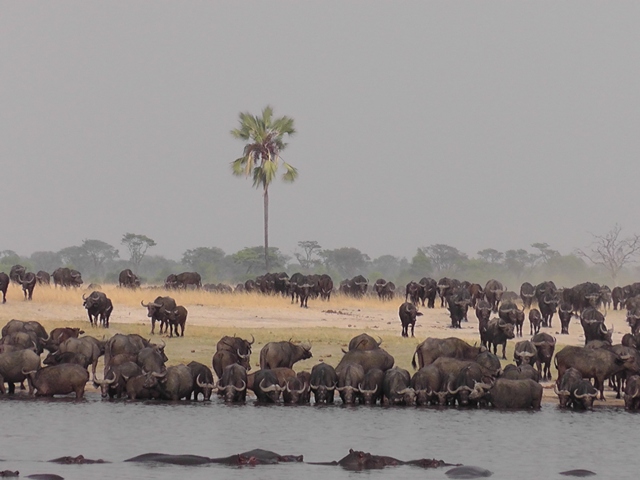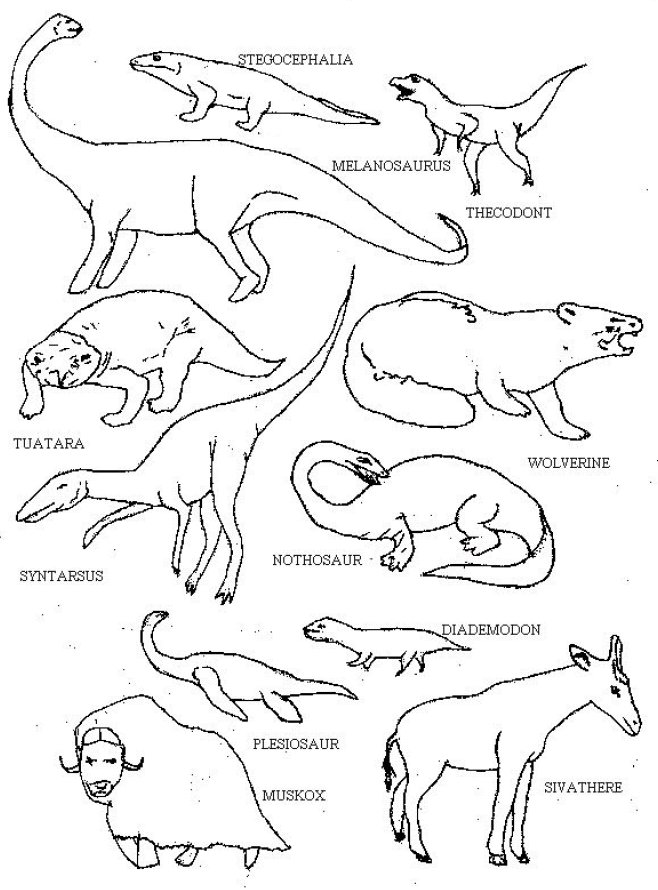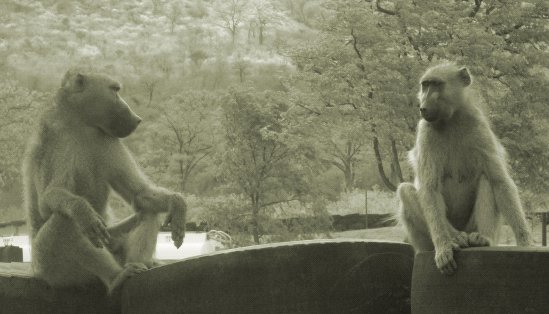 |
 |
Chapter 7 · The Creatures Before
I have compiled a list of large animals found in Southern Africa before the flood:
This list is far from complete as many species are not well known, distributions are unclear and there are possibly many new creatures still to be found. There are sketches to show roughly what many of these creatures looked like.
Large Animals Present before the Flood still found in the Sub-region

Buffalo & Hippopotamuses, at a large watering hole. (... notice the tops of the hippos, in the water...) |
1. Aardwolf.
2. Antbear. 3. Baboons - Some were giants, as big as gorillas and showed great genetic variation. 4. Buffalo - A large buffalo found with molar teeth half as big again as those of the Cape buffalo. The horns reached 9 feet from tip to tip showing that it was a real giant. 5. Cheetah - Some large. 6. Civet - Which was larger than the modern ones. 7. Crocodile. 8. Dog (jackal/wolves) - There were many varieties including a large hunting dog type. 9. Duiker - A type 1.5 times bigger than the common duiker. 10. Elephants (mammoth) - Showing a great genetic variety and some bigger than the modern. Seem to have been common and widespread in the region. 11. Equine (zebra/horse) - Some bigger than modern horses. 12. Felis (most small cats) - Some looked like Lynxes or servals. |
Large Animals Now Extinct
in the Sub-region (similar animals sometimes put together as they may be
sub-species)
44. Abrictosaurus - (awake lizard) an ornithischian bipedal
plant eating dinosaur 1.2 metres long and about 45kg. It had high crowned
teeth. Found in Lesotho.
45. Allosaurus - 5m long carnivorous dinosaur which was in the
Zambezi valley
46. Amphicyon- (two dog) this extinct mammal was about the size
of a modern grizzly bear, about 2 m long. (Although it looked like a bear
with wolf's teeth, it was not a bear). It walked on four, sturdy, legs,
had a short tail and thick neck. Amphicyon ate meat and plants. Fossils
of Amphicyon have been found in Europe (France and Germany) and North America,
Nebraska, USA. This carnivore lived in Southern Namibia.
47. Anchisaurus - (near lizard) A plant eater about 2.5 metres
long. It could walk on four legs. It had serrated leaf-shaped teeth, a
small head, a long neck, a long body, long, thin feet, and a long tail.
Almost complete fossils have been found in Connecticut and Massachusetts,
USA.
48. Australopithecus/Paranthropus - This is possibly a chimpanzee
and it lived in the forests of the Transvaal and Northern Cape. It has
many similarities with the Bonobo (lowland chimpanzee).
49. Bear- A large bear called Agriotherium Africanum said to
have been as big as the Kodiak bear and having long legs. It has similarities
to the Panda bear, which is now found in China. It lived on the coastal
areas of the Western Cape.
50. Brachyopothere - A mammal that looked a bit like a large
hippo-like hornless rhino, with short powerful legs and lived like a hippo.
A specimen was found in Namibia.
|
51. Chalicothere - A large, mostly grass eating herbivore, as big as a rhino, with a long neck and its front legs longer than the back legs. It had large, clawed feet (instead of hooves). It may have been able to rear up on its hind legs to eat leaves high up in trees. It lived in the Transvaal. Fossils have been found in Kazakhstan. 52. Chevrotain - This is a rabbit sized, hornless omnivorous ruminant. An antelope-like animal with large canines. It is still found in the forests of Central Africa and found in Western North America. It likes water, forest and thick undergrowth. 53. Climacoceras - This is a deer-like ruminant with non-deciduous antlers that lived in Southern Namibia. It appears to be in the giraffe family. 54. Colobus monkey - Found in forested parts south of the Sahara and is a specialist leaf eater. It lived in the Transvaal before the flood. 55. Creodont- Hyaenodon. A large carnivore and possible placental. It seems to have lived in the Cape. They lived in Asia, Europe, Africa and North America. Creodonts were quadrupeds with clawed feet, a small brain, large jaws and many sharp teeth. 56. Diademodon - A plant eating mammal-like reptile reaching about 1.5 metres long. 57. Dicynodon - (two dog teeth) these were pig-like, herbivorous therapsids with two large tusks in the upper jaw. Some herbivorous dicynodonts included Boreogomphodon, Lystrosaurus, Kannemeyeria, Estemmenosuchus and Ischigualastia. Lystrosaurus ("shovel lizard") was a plant eater reaching 3 metres long, as big as a hippo, but fatter and having a bigger head. It had tusks and had jaw edges like a turtle. A slow heavily built animal that probably lived in water. There appears to have been a tremendous genetic variety within Dicynodon. Fossils of Lystrosaurus had been found in South Africa, India, Europe, Asia and Antartica. Some carnivorous dicynodonts included Cynognathus, Probainognathus, and Thrinaxodon 58. Cynognathus (meaning "dog jaw") was a cynodont the size of a wolf. This was a fast-moving carnivore (meat-eater) that had four legs and a short tail. It was about 1.5 m long and lived on open plains. It was probably warm-blooded and gave birth to live young. This reptile had dog-like teeth and hunted herbivores. Fossils have been found in South Africa and Argentina. 59. Erythrosuchus - (meaning "red crocodile") A 4.5 metre crocodile looking reptile. Erythrosuchus had long, strong jaws and ate plant-eaters. Fossils were found in South Africa. 60. Eosuchians (meaning "early crocodile") were reptiles and lizardlike diapsids. They walked on four sprawling legs and had a very long tail - some lived in the water (like Hovasaurus). Fossils of Eosuchians have been found in Southern and southeastern Africa and Madagascar. 61. Eunotosaurus - A tortoise-like reptile (not a dinosaur). This amniote was found as poorly preserved fossils showing that it had 8 ribs and some shell (the lower shell was not found and the damaged skull yielded few details). Its fossil was found in South Africa. 62. Euparkeria - Euparkeria was a small, land-dwelling archosauriform. This fast-running quadruped had a semi-erect posture; it could walk on four legs, the front limbs were much shorter than the hind limbs, indicating that it may have been able to run bipedally for short distances. This carnivore (meat-eater) had a long tail, four-fingered hands, large, flexible jaws and many sharp, serrated teeth in sockets. It was about 1.5-ft (0.5 m) long. Fossils have been found only in southern Africa. 63. Euskelosaurus (meaning "good-limbed lizard") was a planteating dinosaur named for its 3-ft (1 m) long thighbone. This enormous browser was about 30-40 ft (9-12 m) long and may have weighed about 1.8 tonnes. A plateosaurid prosauropod, it lived in what are now Lesotho, South Africa and Zimbabwe. Hundreds of fossilized bones have been found. 64. Geosaurus- (rock lizard) A 2.5 metre aquatic crocodilian creature that looked like a cross between a crocodile and dolphin. This streamlined fish-eater had a long, pointed jaw with sharp teeth, four fleshy flippers (the rear flippers were considerably longer than the front flippers) and a long tail with a tail fin. Geosaurus was not a dinosaur, but was a reptile. Geosaurus fossils have been found in Europe (an especially nice specimen was found in southern Germany) and South Africa. 65. Gomphothere - This is an extinct elephant like animal that has tusks in the top and bottom jaws. 66. Gorgonopsid (meaning "Gorgon arch," Gorgon was a beast in Greek mythology whose gaze could turn you to stone, and arch refers to synapsid skull holes) was a synapsid. They had large, powerful, square-shaped jaws with huge, sabre-like canine and interlaced socket-like teeth. Fossils have been found in South Africa. The Gorgonopsidae are divided into 2 sub-families, the Rubidginae, which had large, broad skulls, and the Gorgonopsinae, which comprised most of the gorgonopsid genera. 67. Heterodontosaurus a small, lightly built dinosaur with three different kinds of teeth (hence its name) and a beak. The sharp, cutting front, upper teeth were used for biting against the horny beak, the cheek teeth were for grinding food, and it also had two pairs of long, canine-like teeth that fit into sockets. They may have stored food in cheek pouches. It had five-fingered hands with claws, and three-toed feet with claws. Its back legs were longer than its front legs. It had a long, stiff tail. Heterodontosaurus was about the size of a turkey, 1.3 m long and 50 cm tall. It weighed about 19 kg. Heterodontosaurus was a relatively fast, bipedal (twolegged), dinosaur. It may have run on two legs and walked on four. 68. Hipparion - This is the three-toed horse. This horse was probably common in Southern Africa and found in the Western Cape and Transvaal. 69. Ibex - This may have lived in Southern Africa before the flood. More fossil sites are needed to confirm this, as it may be a mistaken identity. 70. Lesothosaurus - was a small, lightly built dinosaur. It was an herbivore (plant-eater) and a fast, agile runner. It was small and lizard-like, about (1 m long. It walked on two, long, legs, had fourtoed feet, five-fingered hands, short arms, a long pointed tail, a flexible neck, and a small head. Its head was short and flat with large eyes. It had sharp, pointed front teeth and arrow-like cheek teeth, but its lower jaw ended in toothless bone. Two Lesothosaurus fossils were found together in Lesotho, South Africa. Many extra, ground-down teeth were found in the vicinity. The two were found curled up and seem to have died together in the floodwaters. Fabrosaurus may be a sub-species 71. Lycaenops (meaning, "wolf face") was a small therapsid. It was about 3.25 feet (1 m) long, having walked on 4 long legs and had a pointed tail. It was about 16 feet (5 m) long. This meat-eater may have hunted in packs. It had long, deep-rooted canine teeth (fangs); its skull was deeper in front to hold these large teeth. Fossils have been found in South Africa and Europe. 72. Massospondylus. This herbivore was about 4 m long and 1 m tall. It had a long neck, very long tail, a small head, peg-like teeth and large, five-fingered hands with a large thumb claw. Massospondylus may have been able to use its hand for grasping in addition to walking. Its back legs were only a little bit larger than its front legs. It was a very common dinosaur. It swallowed pebbles and small stones to help in the digestion of the tough leaves and other plant material that it ate. These gizzard stones (gastroliths) would help grind up the food in the stomach. Massospondylus walked on four muscular legs and was a relatively fast runner. It may have also run on two legs. Fossils have been found in Namibia, Zimbabwe, South Africa and North America (Arizona). 73. Megazostrodon - it was a tiny quadruped with a long tail, a long body, and a long snout. This mammal was about 10 cm long and weighed only a few ounces. It may have eaten insects. A complete fossilized skeleton was found in Lesotho. 74. Melanorosaurus (meaning "black mountain lizard") was another type of sauropod. It was a large, heavy prosauropod, plant-eating saurischian dinosaur. It walked on four sturdy legs, was about 12 m long, and had a long neck, long tail, thick bones, a bulky body, five-toed feet, and a small head. Its rear legs were longer than its front legs. Its fossils have been found in South Africa. 75. Mesosaurus - (middle lizard) A small to large odd, fresh-water dwelling reptile (not a dinosaur) that lived in the Northern Cape and parts of Namibia. It was probably a fish eater. It was a lightly built, four-legged animal with an elongated head and snout with nostrils near its eyes. It had a flattened tail that was probably used for swimming. It was about 45 cm long. This carnivore probably ate fish and shrimp, catching them with its mouth. It may have reached a size of 15 metres, but appears to have been smaller in Southern Africa. It has some features common with monitor lizards. Fossils have been found in South Africa and South America. 76. Moschops - was a large therapsid. It walked on 4 legs; the front legs were sprawling but the rear legs were more column-like. It was about 5 m long. This possible herding animal had a massive skull and may have engaged in head butting (like modern-day rams). This plant-eater had chisel-like teeth. Fossils have been found in South Africa 77. Muskox - Found in North America and Central Asia, but extinct in Africa. It looks a bit like a shaggy, skinny buffalo with small horns. It appeared to have been present in the Western Cape and Transvaal 78. Nilgai - The short-horned Boselaphine antelope, which is now found only in Southern Asia. It is called the blue cow or Nilgai. 79. Nqwebasaurus -A chicken sized dinosaur found in the Eastern Cape. It was a meat-eating dinosaur theropod with a very large claw on the first digit (finger). Seventy percent of a skeleton (nicknamed 'Kirky') was found in the Kirkwood Formation in the Algoa Basin, Eastern Cape, South Africa. Kirkwood is a small citrus farming village in the Sundays River valley about 30 miles (50 km) north of the coastal city of Port Elizabeth. 80. Nodosaur - A fairly large creature that was heavily built. 81. Nothosaurus - A fish-eating reptile reaching a length of 6 metres. |

|

Will they become humans, should they vote?

| << PREV |
|